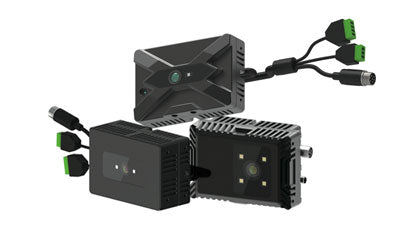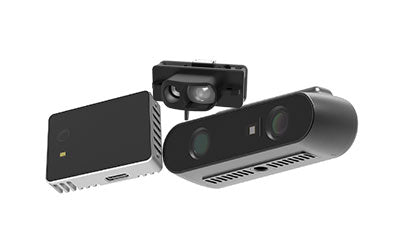New Trends in Consumer Electronics: TOF Drives 3D Sensing Upgrade

With the rapid development of smartphones, tablets, and wearable devices, 3D sensing technology has become key to enhancing user experience and product competitiveness. As an advanced ranging technology, Time of Flight (TOF) is leading the upgrade of 3D sensing in smart devices, driving breakthroughs in face recognition, spatial interaction, and image processing.
1. Strong Demand for 3D Sensing in Smart Devices
With continuous technological advancement, smart devices such as smartphones and tablets no longer just focus on traditional 2D high-definition display but emphasize spatial perception ability of the environment and users. This demand has spurred widespread attention and application of 3D TOF cameras (Time-of-Flight). Compared to ordinary cameras, 3D TOF cameras can measure the time light takes to travel and precisely capture the depth information of objects, enabling true 3D spatial modeling and accurate depth sensing.
Especially in the field of 3D machine vision, 3D TOF technology greatly enriches smart device functionalities. It improves the accuracy of face recognition, making unlocking safer and more convenient; it also promotes applications like background blur (bokeh), AR augmented reality, and gesture interaction, offering users more immersive and intelligent experiences. The popularization of 3D depth camera technology enables devices to accurately judge object distances and shapes in complex environments, providing a solid technical foundation for spatial interaction and environmental perception.
Moreover, with the rise of wearable devices such as smartwatches and smart glasses, there are higher demands on sensor size and power consumption. Users want devices that are lightweight and portable yet offer long battery life, which pushes 3D TOF modules toward miniaturization and low power consumption.
Advanced semiconductor manufacturing processes and optimized sensor designs allow these devices to integrate high-performance 3D sensors within limited space, effectively controlling power consumption and extending usage time to meet diverse daily needs.
In summary, the strong demand for 3D sensing technology in smart devices is driving the rapid development of 3D TOF cameras and related technologies in consumer electronics, pushing smart devices toward higher precision, wider applications, and better experiences.
What is a Time of Flight Sensor?
A Time-of-Flight sensor (TOF sensor) measures the distance to an object by calculating the time taken for a light pulse to travel from the sensor to the object and back. It usually emits infrared light or laser pulses and uses the speed of light and time difference to quickly and accurately obtain 3D depth information. Simply put, a TOF sensor is like a high-precision, fast 'rangefinder' widely used in face recognition, gesture recognition, autonomous driving, robot obstacle avoidance, and augmented reality.
2. Applications of TOF Technology in Face Unlocking, Background Blur, and Spatial Interaction
TOF sensors precisely measure the time light pulses take to travel to and from an object, enabling high-precision distance calculation between objects and devices, thereby constructing a complete and detailed 3D vision system. This technology plays a key role in multiple core applications within smart devices.
In face unlocking, TOF technology greatly enhances the security and reliability of identity authentication. Traditional 2D cameras rely only on flat images and are vulnerable to spoofing via photos or videos. With TOF sensors, devices capture the 3D depth information of users’ faces, building real 3D face models. Combined with advanced algorithms, systems accurately recognize facial contours and minute details, effectively preventing spoofing attacks, ensuring user privacy, and providing a more secure and convenient unlocking experience.
In photography, TOF sensors obtain real-time depth information of scenes, significantly improving the quality of background blur (bokeh) effects. Traditional software-based blur on 2D images often causes unnatural edges or fails to separate subjects cleanly. TOF technology provides accurate depth maps that clearly distinguish between blurred background and subject, creating more natural depth effects and allowing users to take professional-level photos comparable to DSLR cameras without needing specialized equipment.
Furthermore, TOF technology shows huge potential in augmented reality (AR), virtual reality (VR), and intelligent spatial interaction. Combined with RGB-D cameras, which capture both color and depth, TOF sensors provide comprehensive data for spatial modeling and object recognition in virtual environments.
Coupled with powerful AI chips, systems can analyze and understand user movements in real time, enabling precise gesture recognition and smooth virtual interactions. For example, users can control virtual objects, navigate interfaces, or play games through gestures, with TOF ensuring immediate and accurate interaction, enhancing immersion and ease of use.
In conclusion, TOF technology with its unique depth sensing capability is a key technology supporting secure face unlocking, professional-grade background blur, and intelligent spatial interaction in smart devices, driving their development toward smarter, more convenient, and user-friendly directions.
3. TOF Deployment Trends in iPhone and Android Flagship Models
As consumer demands for human-machine interaction, security authentication, and immersive experiences grow, 3D TOF cameras are rapidly evolving from industrial use to mainstream consumer electronics, becoming essential sensing hardware for smart devices. In recent years, the competition between Apple and Android flagship models in TOF deployment has greatly promoted the popularization and evolution of 3D sensing technology.
Since introducing Face ID with iPhone X, Apple has continuously optimized its 3D face recognition system. Starting from iPhone 12 Pro and later models, Apple uses rear TOF modules (LiDAR Scanner) to significantly enhance ARKit spatial perception and depth modeling in complex environments. TOF in iPhones supports not only high-precision 3D face recognition for Face ID, but also night portrait photography, autofocus assistance, distance measurement, and other imaging and sensing features, showcasing integrated technological advantages.
The Android camp shows more diverse TOF applications. Brands like Samsung, Huawei, Xiaomi, and OPPO have equipped their high-end models with TOF sensors, leveraging AI algorithms to improve background blur (bokeh) in photography, optimize portrait modes, and compete in AR/VR, virtual try-on, and spatial mapping functions. For example, Xiaomi Mix series incorporates TOF cameras to enhance AR gaming experiences, while OPPO launches TOF-based 3D gesture controls, enabling non-contact phone operation.
Hardware-wise, TOF modules are rapidly moving toward miniaturization (mini lidar / miniature lidar) and low power consumption to meet the core demands of slim devices with long battery life. Current TOF modules feature higher integration, smaller packaging, and use low-power VCSEL emitters and advanced CMOS receivers to reduce power consumption. Additionally, collaboration with AI chips allows TOF modules to perform complex tasks like gesture recognition, human detection, and environmental modeling locally without relying on cloud computing, further enhancing device intelligence.
Looking ahead, TOF technology will deeply penetrate consumer electronics. As more mid-to-high-end Android devices adopt TOF modules and AI vision platforms mature, TOF is expected to work synergistically with ultra-wide, periscope telephoto, and other camera modules to form comprehensive spatial vision systems. Its value in immersive AR, AI photography, 3D modeling, and spatial interaction will continue to be unlocked, delivering users more natural, intelligent, and secure experiences.
4. Multi-Camera Collaboration: The Cooperative Architecture of RGB + TOF + AI Chips
With continuous hardware upgrades in smart devices, the demand for enhanced perception capabilities rises, and single-type cameras can no longer meet complex computer vision requirements. In response, multi-camera collaboration (camera SLAM / SLAM camera) has become a key industry trend. Especially the combination of RGB cameras with TOF depth sensors forms a more comprehensive RGB-D fusion system (RGBD system), providing a solid hardware foundation for 3D perception.
In this collaborative architecture, the TOF sensor precisely captures depth information of the scene, while the RGB camera provides high-resolution color images. By fusing these data, a rich 3D visual input is formed, not only improving the accuracy of spatial modeling but also greatly enhancing recognition of object edges, contours, and materials. More importantly, this process is accelerated and processed in real-time by embedded AI chips, which leverage deep learning algorithms to efficiently perform inference from image recognition to semantic understanding.
This cooperative architecture profoundly impacts the development of 3D visual SLAM (Simultaneous Localization and Mapping) technology. Traditional SLAM often faces localization drift or unstable maps in dynamic environments, but with TOF integration, the system continuously provides high-precision, low-latency depth data, significantly enhancing SLAM robustness in complex scenarios. Meanwhile, the combination of RGB images and AI algorithms enables the system with semantic perception ability, recognizing different object categories and understanding spatial layouts, thus achieving smarter path planning and environment interaction.
In practice, this multi-camera collaborative architecture is widely applied in indoor navigation, augmented reality, intelligent security, and robotic vision systems. For example, robotic vacuum cleaners use RGB-D SLAM systems for more efficient path planning and obstacle avoidance; AR glasses accurately recognize the user’s space and overlay virtual content in real time, offering immersive augmented experiences.
In summary, the RGB + TOF + AI chip cooperative architecture significantly boosts terminal devices’ visual perception capability and provides strong technical support for various intelligent functions. It is gradually becoming the standard configuration for intelligent hardware perception systems, driving 3D perception and spatial intelligence to higher levels.
5. Cutting-Edge Trends: Miniaturization and Low Power Consumption of TOF Modules
With smart devices trending toward thinner and more portable designs, miniaturization and low power consumption of TOF modules have become key directions for 3D sensing technology development. Especially in smartphones, tablets, and wearables, users demand better spatial layout and longer battery life, pushing TOF modules to optimize volume and energy efficiency while maintaining accuracy and stability.
Currently, TOF modules are rapidly moving toward micro lidar integration. By highly integrating multiple optical components, driving circuits, and processing units into a single package, the TOF modules significantly reduce size, freeing up space for product design. Meanwhile, advanced semiconductor manufacturing processes continue to improve — for example, smaller process node CMOS fabrication, high-performance VCSEL lasers, and integrated optical packaging enable TOF sensors to achieve faster response, higher precision, and lower power consumption, perfectly suited for long-term operation in mobile terminals.
Additionally, to fully unleash TOF modules’ potential in diverse scenarios, TOF systems are deeply integrated with AI algorithms. Utilizing neural network models and edge computing technologies, TOF modules can directly perform complex tasks such as object recognition, gesture tracking, and scene understanding on-device, greatly reducing reliance on the cloud, improving response speed, and enhancing user privacy. This AI + TOF + chip combination also accelerates 3D sensing technology’s expansion from consumer electronics to broader application fields.
In the field of robotic vision (robots 3D), miniaturized TOF modules can be integrated into service robots, warehouse robots, and unmanned delivery devices to provide refined spatial navigation, obstacle recognition, and environmental mapping capabilities. In autonomous driving, TOF modules serve as an important short-range precise supplement, supporting parking assistance, in-cabin gesture control, face recognition, and other intelligent functions.
Looking ahead, the miniaturization and low power consumption of TOF modules will not only enhance hardware adaptability but also open up more possibilities for the 3D sensing industry. With collaborative progress in chip technology, packaging processes, and algorithm optimization, TOF will become more widely deployed across smart terminals and vertical application scenarios, leading a new wave of upgrades in human-computer interaction and spatial perception technology.
Summary
As a precise and efficient 3D ranging technology, TOF is profoundly transforming the 3D sensing landscape of smartphones, tablets, and wearables. In the future, continuous miniaturization and low power consumption of TOF modules, combined with multi-camera collaboration and AI chip integration, will lead consumer electronics toward a smarter and more user-friendly 3D interaction era.
Synexens Industrial Outdoor 4m TOF Sensor Depth 3D Camera Rangefinder_CS40
Our professional technical team specializing in 3D camera ranging is ready to assist you at any time. Whether you encounter any issues with your TOF camera after purchase or need clarification on TOF technology, feel free to contact us anytime. We are committed to providing high-quality technical after-sales service and user experience, ensuring your peace of mind in both shopping and using our products





